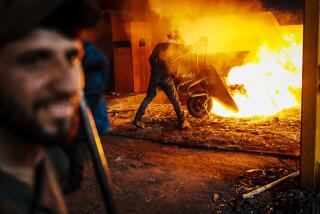Afghanistan Still Needs Us
- Share via
While the U.S. focuses on Iraq and North Korea, it has 9,000 troops risking their lives in Afghanistan to rid the country of the Taliban and Osama bin Laden’s Al Qaeda troops. The largest battle there in 10 months gave graphic evidence last week that the war is not over. Although there were no American casualties in at least 12 hours of fighting in the mountains of southeastern Afghanistan, days later four Americans were killed when their Army Black Hawk helicopter crashed near the Bagram air base not far from the capital, Kabul.
Army officials said an accident, not hostile fire, downed the helicopter, but rocket attacks on U.S. forces and allies along Afghanistan’s border with Pakistan have occurred in recent months.
There is something even more worrisome than rocket fire: Taliban forces that had dispersed under withering air and ground attacks are re-forming in units of 50 or more to challenge U.S. troops. That means a longer, costlier presence than Washington had hoped for. It also requires a renewed commitment to prevent Afghanistan from slipping back into the chaos and warlord rule that let the Islamic fundamentalist fighters gain control of the country.
In his State of the Union speech, President Bush pledged to help Afghans “secure their country, rebuild their society, and educate all their children -- boys and girls.” The words need to be matched by action. Afghans remember the U.S. losing interest in the country after the Soviet invaders were ousted in 1989.
If the United States can’t stick to its promises to the Afghans, Iraqis would have justification to wonder whether the U.S. would remain there to help that country rebuild after a war.
The United States has begun to deploy provincial reconstruction teams, protected by Special Forces troops, to build roads and schools across Afghanistan. Once U.S. troops make it safe for farmers to tend their fields and villagers to draw water from wells, U.S. Agency for International Development teams can undertake larger projects: building hospitals, pouring tar for roads to connect cities, putting up mills for grain.
President Bush promised a Marshall Plan-style rebuilding of Afghanistan; much of the more than $700 million the U.S. provided last year went not for rebuilding but for emergency needs such as resettling refugees and providing food to avert starvation.
Congress last year belatedly approved spending more than $3 billion during the next four years for Afghanistan’s reconstruction. The Senate and House now must ensure that the money is appropriated. The United States went to war in Afghanistan because the Taliban sheltered the Al Qaeda terrorists who attacked America on 9/11. It cannot let the nation become a haven for terrorists again, for the sake of Afghanistan and for U.S. well-being. Rebuilding the country’s institutions will provide needed stability for a strong central government.
More to Read
Sign up for Essential California
The most important California stories and recommendations in your inbox every morning.
You may occasionally receive promotional content from the Los Angeles Times.













